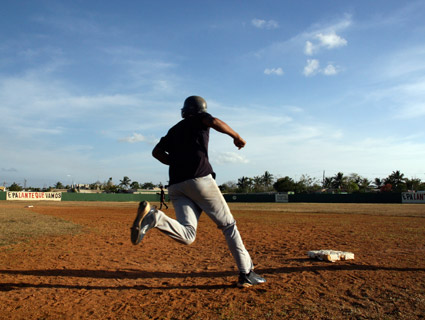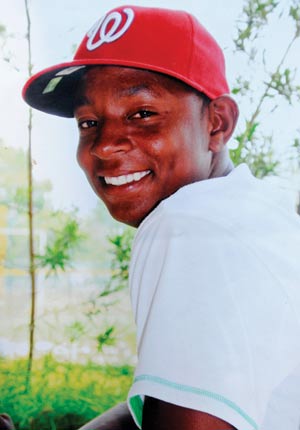
The baseball men started coming around when Yewri Guillén was 15. Like thousands of other boys in the Dominican Republic, he had been waiting for them for years, training on the sparse patch of grass and dirt across the road from the small concrete-and-wood house he shared with his mother, father, and two sisters in La Canela, a hamlet 45 minutes southwest of Santo Domingo. By the time the American scouts took notice, he had grown into a 5-foot-10, 165-pound, switch-hitting shortstop with quick hands and a laser arm. In 2009, at the age of 16, he signed for $30,000 with the Washington Nationals. The first thing he’d do with his bonus, he told his parents, was buy them a car and build them a new house.
But soon after Guillén’s signing, Major League Baseball put his plans on hold. The league, having grown more vigilant about identity fraud, suspended him for a year, alleging that he’d lied about his date of birth on paperwork to boost his potential value to scouts. Guillén’s family got a lawyer to fight the suspension, and in the meantime he lived and trained without pay at the Nationals’ academy in Boca Chica, the epicenter of MLB’s training facilities in the country. There, he was notoriously hard on himself. Johnny DiPuglia, the Nationals’ international scouting director, said Guillén would even take himself out of games after making small mistakes like missing a sign from the third-base coach. “He had no education, none at all,” DiPuglia told me. “I didn’t think he had any teeth because he never smiled. And he always had watery eyes—there was always sadness in his eyes.”
DiPuglia made it his mission to cheer up the teenager, “to open up his heart.” He wouldn’t let Guillén pass without giving him a hug and a smile, and little by little, DiPuglia said, Guillén started to loosen up, becoming a better teammate and a happier kid. Later, when other talent brokers approached Guillén claiming that they could get him a better deal with a different team, Guillén turned them away because he felt that he owed it to the Nationals for sticking with him. After MLB finally authorized his contract at the beginning of 2011, the Nationals told him they’d be sending him to play for their rookie league team in Florida. He was to leave in mid-April.
When the headaches first came on, they were barely bad enough to mention. On April 1, Guillén headed home to La Canela to get his travel documents in order. His family brought him to a clinic in nearby San Cristóbal. When he returned to the academy and missed a couple of games, DiPuglia called him out—in the Dominican Republic, nobody rides the bench because of a headache. When the pain got worse, DiPuglia sent Guillén to the trainer’s room, where he was given some tea and an aspirin.
The next day, on April 6, the Nationals sent Guillén back to La Canela. He had a slight fever when he left the academy. On April 7, Michael Morla, a longtime local trainer who also acted as Guillén’s agent, was at the field in La Canela when he saw Guillén, a damp towel wrapped around his head, lurching toward the community’s health post, adjacent to the field. Morla approached Guillén’s family, urging them to take him to Santo Domingo for care: “The boy is bad!”
Guillén’s aunt and uncle rushed him to the Clínica Abreu, the capital’s best private hospital. But because his contract hadn’t been finalized he didn’t have health insurance, and he was refused treatment when his family couldn’t come up with the $1,300 admission fee. His aunt and uncle moved him to a more affordable Cuban-Dominican clinic nearby, where he was admitted on April 8. The doctors diagnosed bacterial meningitis. Guillén later had surgery to drain brain fluid, but the disease had progressed too far. On April 15, the day he was to leave for the United States, Yewri Guillén died.
The tragedy was a blip on the sports world’s radar, a blurb on ESPN’s Spanish-language crawl. The handful of news reports hit all the same notes: MLB said that the team followed appropriate protocols and did all that it could; the Nationals vowed to promptly vaccinate all the players at their academy; everyone from the team’s medical director to the general manager expressed sorrow about the death.
Here’s what those stories left out: There wasn’t a certified athletic trainer, let alone a doctor, to evaluate Guillén at the Nationals’ academy, a spartan training camp with cinder-block dorms. No one from the team accompanied him to Santo Domingo or intervened when he couldn’t get into the Clínica Abreu. (The club didn’t cover the costs of his treatment until after he was admitted to the Cuban-Dominican clinic.) And following Guillén’s death, the club required his parents to sign a release before handing over his signing bonus and life insurance money—a document also stating that they would never sue the team or its employees.
Guillén’s death is the worst-case scenario in a recruiting system that treats young Dominicans as second-class prospects, paying them far less than young Americans and sometimes denying them benefits that are standard in the US minor leagues, such as health insurance and professionally trained medical staff. MLB regulations allow teams to troll for talent on the cheap in the Dominican Republic: Unlike American kids, who must have completed high school to sign, Dominicans can be signed as young as 16, when their bodies and their skills are far less developed.
“A 16-year-old doesn’t know how to play baseball,” the Boston Red Sox’s David Ortiz, an eight-time All-Star who grew up in Santo Domingo, told me. “I don’t care what they say. When I signed at 16, I didn’t know what the fuck I was doing.”
Teams are not eager to talk about the disparity between MLB’s domestic and foreign rookie leagues, as I would learn firsthand when looking into Guillén’s death in his native country. Nor is it much of a concern to locals: The sport is ubiquitous and beloved, and given the Dominican Republic’s 40 percent poverty rate, the allure of the big leagues is powerful. Ortiz said Americans don’t understand the pressure on Dominican teenagers, including in some cases to lie about their age. “The thing that made me mad about the whole situation is that people want to look at us like we are criminals,” he said. “I would like to get in their face and ask them, if that was their only way out, what would they do?”
The legions of teens swinging bats and diving for ground balls each year on Dominican fields must negotiate a system with little in the way of support or a safety net. Whereas Major League Baseball requires all 189 minor league teams in the United States to have certified athletic trainers and “all reasonable medical supplies,” no such requirement exists at the Dominican academies. Nearly two years after Guillén’s death, Mother Jones found that 21 of MLB’s 30 teams lack certified trainers in the Dominican Republic, including the Nationals.
Rafael Pérez, head of Dominican operations for Major League Baseball, said his office’s role is to provide services to the clubs, not wag a regulatory finger at them: “Sometimes people have a negative reaction when things are imposed,” he said. That’s why the Nationals faced no sanctions, even though one of their players died of an entirely treatable illness. They had followed the rules, but those rules don’t require the teams to do very much. Pérez insisted that the league has aimed to improve facilities and standards in recent years, albeit on a voluntary basis: “Some clubs are having a harder time than others. But they all have great intentions.”
The reality is that a stark double standard persists, said Arturo Marcano, a Venezuelan-born lawyer who a decade ago coauthored a book on corruption and youth exploitation in MLB’s Dominican operations. League officials recognize that the system is flawed and that it should be improved, he said. “They always say, ‘We’re working on it,’ or, ‘Things are getting better.’ But in the end, it’s the same response they’ve been giving since 2002.”
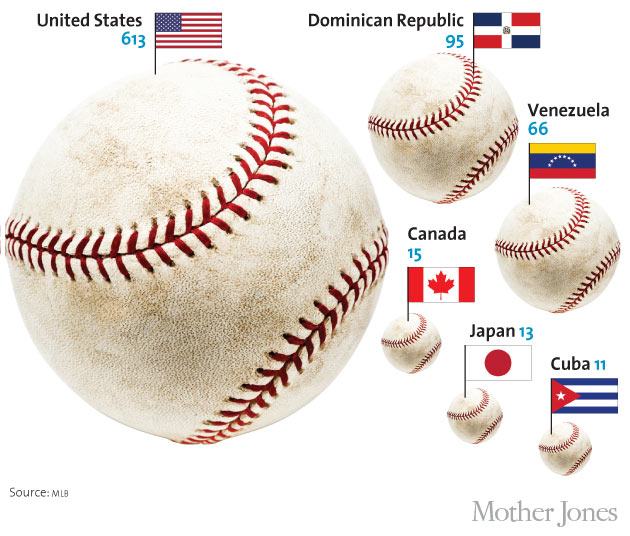
Since then, Latin American players have become an ever more important part of the game. At the start of the 2012 season, players born in Latin American countries made up 42 percent of minor leaguers and 24 percent of major leaguers. They accounted for 6 of MLB’s 25 highest earners, and like superstar Albert Pujols, who signed a 10-year, $240 million contract in December 2011, more than half of the Latin American players came from the Dominican Republic, the most from any country outside the United States.
And yet, if 2006 is any indication, of the hundreds of Dominican prospects at the academies each year (along with Venezuelans and other Latin Americans also training there), less than half will ever leave the island to play even in the minor leagues, let alone in the big show, where under 3 percent will eventually step up to the plate. More than three-quarters will drop out of baseball in four years. Americans in the rookie leagues also face long odds, of course, but nearly 70 percent of them will advance at least one minor league level, and they are more than four times as likely to crack a major league roster. They are also far better paid at the outset: The average signing bonus for American players drafted in 2011 was $232,000; for international players, it was approximately half that.
Everyone participating in the system—from the CEOs of major league franchises all the way down to the often sketchy local talent brokers in the Dominican Republic known as buscones—has a say. Except for the kids. “The objective in Latin America is to sign talent, but do so in an affordable way,” Marcano said. “But there isn’t anyone who speaks for the players, who are giving up their childhood in search of a dream that few realize.”
Baseball first came to the Dominican Republic in the late 1800s, most likely brought to the island by Cuban immigrants. Although several teams formed and began playing tournaments by the early 1900s, it wasn’t until Ozzie Virgil debuted for the New York Giants in 1956 that a Dominican made it to the American major leagues. Several accomplished players followed, including Hall of Fame pitcher Juan Marichal, but the first real wave came after Toronto Blue Jays scout Epy Guerrero started the first academy in 1973, turning a house and a cheap plot of land into a rudimentary training camp. A decade later, the Los Angeles Dodgers, recognizing a potentially rich vein of talent, created a template for the contemporary baseball academy called Campo Las Palmas. But most teams were content to play the odds, parachuting in to look for big-time talent at bargain basement prices. As former Colorado Rockies executive Dick Balderson once explained, “Instead of signing four American guys at $25,000 each, you sign 20 Dominican guys for $5,000 each.”
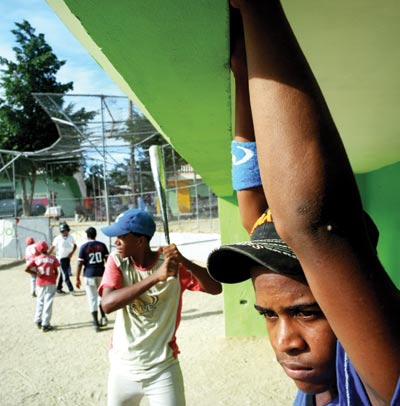
Conditions at some academies were substandard and even dangerous. When the Nationals’ DiPuglia was starting out with the St. Louis Cardinals in the mid-1990s, his players slept eight to a room and navigated a field full of rocks and the occasional goat. In his book, Stealing Lives, Marcano told the story of a player named Alexi Quiroz and his path through the Chicago Cubs’ Dominican academy, a place the ballplayers referred to as “Vietnam.” There, 19 teenage boys shared one bathroom without running water, a drunk coach allegedly threatened them with a gun, and, after Quiroz separated his shoulder playing shortstop one day, he was treated by a street doctor who stomped on the joint to pop it back into place, ending his career.
As American teams began paying more attention to Dominican prospects in the early aughts, more and more ex-players and wannabes started working as buscones, scouting and training teens even before they had turned 16. They had flashy nicknames like Cachaza or Aroboy, and their training methods and negotiating tactics led to rising bonuses for their players—typically along with a hefty 30 percent cut for their efforts. Some buscones gained a reputation as ruthless operators willing to do anything—forge player birth certificates, bribe investigators—to boost their take.
By 2009, following several high-profile identity fraud cases and bonus-skimming scandals, MLB dispatched executive Sandy Alderson (now the general manager of the New York Mets) to take stock of operations in the country. His report called for restructuring the league’s Dominican office, improving identity investigations, regulating the buscones, and generally curtailing corruption.
But his recommendations were only advisory, and critics maintain that little has changed since. One big shift did go into effect in 2012: Major League Baseball restricted teams to a $2.9 million international free-agent budget, in part to blunt the power of buscones by driving down signing bonuses. The bonuses had hit a high point the prior year, when the Texas Rangers signed 16-year-old Dominican outfielder Nomar Mazara to a record $4.95 million deal, but since have begun to drop and will remain suppressed under the cap. A few teams, such as the Pittsburgh Pirates and San Diego Padres, have chosen to invest in better facilities and training programs, but they remain in the minority.
The Nationals, meanwhile, have been tight-lipped about their operation since Yewri Guillén died. (MLB later said Guillén had died of a sinus-related infection, not meningitis, but league officials declined to provide Mother Jones with any documentation confirming such a diagnosis.) And access to the team’s academy proved challenging. Shortly after I arrived in the Dominican Republic in January 2012 and scheduled a tour of the Nationals’ facilities, I received an email from team administrator Fausto Severino retracting the invitation: The visit was “not going to be possible for the moment.”
I headed over to the academy anyway. My cab driver drove out of downtown Boca Chica on a street that quickly gave way to a trash-lined dirt track. After a few bumpy minutes, the road dead-ended in front of the entrance, which had a large Nationals logo painted on the wall. A security guard sat near the metal gate, chitchatting with a couple of players, an empty batting cage behind them.
Eventually the guard stood up and waved me in. With its smallish concrete dorms, the facility was humble compared to the country’s high-end academies, including the $6 million Pirates complex I’d visited a few days before. But it wasn’t unpleasant, either; palm trees lined two well-manicured fields beyond the gravel driveway.
The guard suggested there was a kind of family atmosphere to the place, mentioning how some players who’d made it to the minor leagues came back in the offseason to work out. He seemed happy to talk, so I asked him if he knew the player who died.
“Ah, yes,” he said, his voice dropping a little. “Yewri, he got sick, went home, and passed away. So sad.”
I asked if he thought the team did right by Guillén’s parents.
“They collected money,” he said. “But what’s that to a family that lost a child?”
DiPuglia would tell me later that he saw the settlement deal as fair. “We pushed it through,” he said, noting that the team’s owners were under no contractual obligation to give Guillén’s family the $30,000 bonus or the $50,000 insurance payout. “I think they did the right thing, the humane thing.”
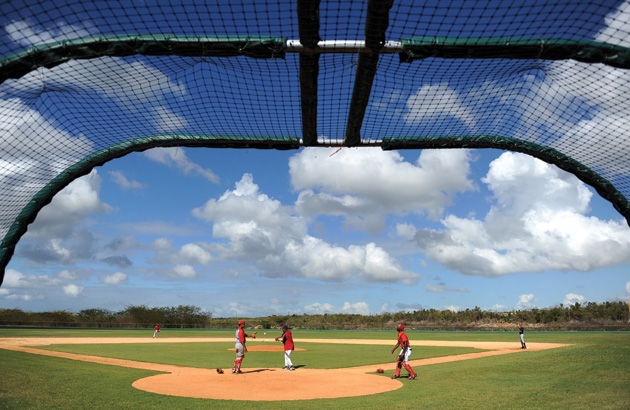
Or was it just the relatively small cost of doing business? To hear veteran buscón Astin Jacobo Jr. tell it, locals are well aware that they’ve gotten the short end of the deal for a long time—even as some aggressively pursue their own stake in the recruiting game. Prior to checking out the Nationals’ academy, I’d gone to meet with Jacobo in a resort town near his home base in San Pedro de Macorís, the legendary “cradle of shortstops” that has produced the likes of Alfonso Soriano and Robinson Canó.
As we sat down at a beachfront restaurant for a round of beers, it was hard to miss the costume ring Jacobo was sporting, a long-maned golden lion with faux-diamond eyes. First, he insisted that he wasn’t a buscón, because that label implies someone who makes money without working, and he definitely works hard for his cut. Then he got right to the point about the market for raw talent. “It’s not a secret to anybody that we were being taken advantage of for the last 50 years,” he said, smiling. “The kind of players that we signed, for the kind of money that we sold those players, I mean, it’s amazing.”
Jacobo, who grew up in the Bronx, knows the history of the business. Long before emigrating to the United States, his father, Astin Jacobo Sr., was one of the first successful proto-buscones in the Dominican Republic, operating as a de facto broker for players who lived in the sugarcane mill towns around San Pedro de Macorís in the 1960s and ’70s. Many of them, like Astin Sr. himself, were cocolos, or dark-skinned immigrants from the English-speaking West Indies. If an MLB scout back then suggested to Astin Sr. or his contemporaries that a 19-year-old wasn’t worth signing, more often than not the kid would have a birth certificate in hand the next day showing he was 16. Even the tiny-sounding sums paid to prospects then exceeded the wildest dreams of most Dominicans. And like his son years later, Astin Sr. would get his slice.
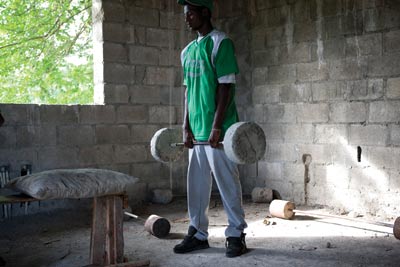
As the table filled up with emptied Presidente Lights, Jacobo stepped up his criticism of Major League Baseball, which he said is only interested in reform insofar as it reduces teams’ financial risk. He ticked off a list of wealthy Dominican stars who’ve made untold sums for their clubs and the league—and who were signed for next to nothing back in the day: “Sammy Sosa: $3,500. Miguel Tejada: $2,000. Vladimir Guerrero: $1,800. Trust me, if it was still like that, MLB would never talk about it.”
Jacobo claimed that he and others ushered in higher signing bonuses by developing private academies for Dominicans as young as 13 years old. The idea was to better prepare players for showcases, which then helped buscones push for more money from major league teams come negotiation time. To those who charge that buscones take too big of a cut, Jacobo said that on average he spends $10,000 on each player he trains, housing, feeding, and even clothing them until they sign. “And if he’s a very special player? You might end up spending $30,000 on a guy who is not your son.”
After putting in all that work, he added, he’d be damned if anyone, MLB or otherwise, was going to limit how much he earns. “I have to tell you this,” Jacobo said, the sun dipping behind the seaside shops. “We don’t care what price they want to put on our players. They’re our players. It’s going to come down to how much I want to sell them for.”
La Canela isn’t so much a town as a smattering of houses off a winding two-lane coastal road, a way station between the Gatorade bottling plant in Haina and the Padres’ $8 million academy in Najayo. The day I visited, the field where Yewri Guillén once played was filled with romping preteens shagging fly balls and taking turns swinging a cracked aluminum bat. Guillén’s former mentor Michael Morla surveyed the scene from behind the first-base dugout, reflecting on the 50-plus players he’d signed to pro contracts since starting his own training program here 15 years ago. Scouts had been showing up frequently to watch Morla’s latest star, Fernery Ozuna, another strong-armed, line-drive-smacking prospect.
“The only player I’ve had who could throw harder than this kid was Yewri,” he said. “Guillén was tremendous. Tremendous.”
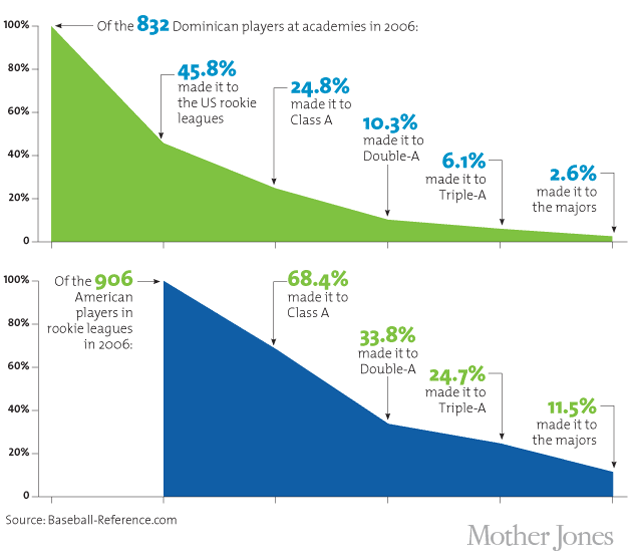
Morla still wasn’t sure how to reconcile Guillén’s death. If MLB hadn’t dallied so long with its identity investigation, he said, maybe Guillén would’ve been in the United States a year earlier. If the Nationals had sent him to a physician instead of back home to impoverished La Canela, maybe the infection would’ve been treated successfully.
He pointed me across the road, where several men were sitting in plastic chairs in front of a bright white house with curving iron bars and the letters “Y” and “G” on the facade. I introduced myself to Carlos Guillén, Yewri’s father, a chocolate-skinned man with short-cropped silver hair and a raspy voice. His initial answers to questions about his dead son came out in staccato bursts. He started playing when he was a kid. He played here. Yeah, I played. I was a pitcher. The scouts called him a prospect. Everyone said he would go far.
I asked him about his son’s illness. “He was sick there in the academy,” he said. “And then they sent him here sick.”
As he recounted the nightmare, his brother, Bienvenido Ortiz, interjected, saying he was the one who’d introduced his nephew to the game. “The only way for a boy to get millions right now in this country, without being an engineer, is baseball,” Ortiz said. When Guillén fell ill, he said, he was the one who called around to get his nephew into a hospital and paid for him to be admitted. And when Guillén died, he said, he was the one who wanted to sue the Nationals.
“I told him,” Ortiz continued, motioning toward his brother. “‘Read the contract. A few strange things are going to show up in there.'”
Ortiz showed me the agreement Guillén’s parents signed a month after the funeral, a notarized document that I photographed before handing it back. Exactly when and how Guillén became ill remains unclear to this day. But in 2011, in return for Guillén’s $30,000 signing bonus, his parents agreed to the following terms:
(1) that Guillén died of bacterial meningitis, but that he’d contracted it outside of the facility and therefore it had nothing to do with the Nationals;
(2) that the team gave Guillén the appropriate treatment when he got sick;
(3) that they would never sue the team or its employees for the death of their son.
“They came here to screw us over,” Ortiz said, his voice rising. “We didn’t want problems—we just wanted things to be resolved.”
Carlos Guillén looked off at the ball field across the street. It was empty; the kids had all gone home for lunch. Guillén’s mother, Sandra Perdomo, later told me that despite the settlement she felt that the Nationals had forgotten about her son. Team officials always used to talk about how they were one big family, she said, “but then what happens? A month and a half after he died, I never heard from them again.”
MLB’s Rafael Pérez maintains that the league and the Nationals did everything they could. Pérez worked for the Mets at the time, and upon hearing the news, he said, he reviewed his own team’s emergency plan. The Guillén tragedy, he said, raised teams’ awareness: “I think we all understand that it could’ve happened any other place.” But when pressed about his team’s plan for dealing with medical emergencies at the time, or changes to those procedures since, he said, “I cannot go into the details of that. Just put it this way: I think great things came out.”
After leaving the Guillén home, it was a short cab ride from La Canela to the tiny Iglesia San Antonio, perched on a small hill just off the road in Nigua. I scanned the church’s graveyard, an overgrown, uneven plot filled with aboveground vaults. It took 20 minutes and a phone call back to La Canela to locate Yewri Guillén’s final resting place, but eventually I found it, off to the far right.
The Nationals’ DiPuglia, shaken by the tragedy, told me that shortly after Guillén’s death he’d felt like he needed to come here to the grave, to ask for forgiveness. He hadn’t meant to be so hard on the kid, coming down on him for missing a few games because of a stupid headache. “He was like a son,” DiPuglia said, pain in his voice. “A second son.”
The lower half of the vault was painted a bright sky blue, but the top half was plain concrete, rebar poking out at the corners. A dirty candleholder sat in front of a whitewashed cross, where the teen’s first name was misspelled: YEWRY N. GUILLEN P. It was a hushed place in midafternoon, far removed from the busy ball field just minutes away.
This story was supported by a grant from the Investigative Fund at The Nation Institute.

